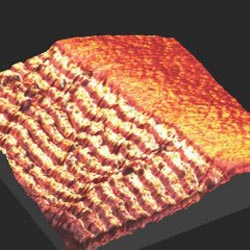Physicists Take an Atomic-Level Peek at Unexpected Behavior in Multilayered Structures

University of Arkansas<br><br>Cross-sectional image of the multilayer structure on nanoscale<br>
A new class of materials developed at the University of Arkansas may influence the next generation of nano-devices, in which integrated circuits are composed of many layers of dissimilar materials, such as ferromagnetic and superconducting oxides.
The researchers used innovative cross-sectional scanning tunneling microscopy and spectroscopy at the U.S. Department of Energy’s Argonne Center for Nanoscale Materials to develop the first direct view of the physical and chemical behavior of electrons and atoms at boundary regions within the dissimilar materials.
“The fundamental issue here is that conventional modern day electronics based on silicon is very problematic to operate on a nanometer scale,” said Jak Chakhalian, professor of physics in the J. William Fulbright College of Arts and Sciences at the University of Arkansas. “Integrated circuits have many, many layers of functional material. As layers get thinner, the materials start behaving strangely and often unreliably. Now the question of the size of the interface, where two materials ‘talk’ to each other or influence each other, becomes critical.”
An article detailing the finding, “Visualizing short-range charter transfer at the interfaces between ferromagnetic and superconducting oxides” was published Aug. 13 in the online journal Nature Communications.
Te Yu Chien, a former postdoctoral research associate at the university, developed a technique at the Advanced Photon Source at Argonne to help Chakhalian’s research group with an easy way of looking directly at the interfaces between two dissimilar oxides.
“That was the breakthrough,” Chakhalian said. “He found the ‘knife’ that would cut through the multilayered ‘sandwich.’ Previously, it was extremely difficult, if not impossible, to look inside the layered complex oxide nanomaterial that we had developed here in our lab because they fractured when they were cut.
Chien’s technique provided the researchers with crucial information: Not only do the atomic layers talk to each other, but they also deeply influence each other on a one- to two-nanometer scale.
“We learned that in our materials, the layers strongly influence each other,” Chakhalian said. “For the first time, we showed how electrons and ions interact on the atomic scale in those complex multilayered structures, and it was not what a lot of people expected. This is fantastic. So now we can have beautiful control of these materials on the atomic scale obtained right at the interface, which defines the properties of those materials.”
Chakhalian holds the Charles E. and Clydene Scharlau Endowed Professorship and directs the Laboratory for Artificial Quantum Materials at the University of Arkansas.
The results were obtained by a collaborative effort with John W. Freeland of the Advanced Photon Source and Nathan P. Guisinger of the Center for Nanoscale Materials, both at Argonne National Lab outside Chicago; and Lena F. Kourkoutis and David A. Muller at the Kavli Institute at Cornell for Nanoscale Science in Ithaca, N.Y.
CONTACT:
Jak Chakhalian, professor, physics
J. William Fulbright College of Arts and Sciences
479-575-4313, jchakhal@uark.edu
Media Contact
More Information:
http://www.uark.eduAll latest news from the category: Physics and Astronomy
This area deals with the fundamental laws and building blocks of nature and how they interact, the properties and the behavior of matter, and research into space and time and their structures.
innovations-report provides in-depth reports and articles on subjects such as astrophysics, laser technologies, nuclear, quantum, particle and solid-state physics, nanotechnologies, planetary research and findings (Mars, Venus) and developments related to the Hubble Telescope.
Newest articles

Trotting robots reveal emergence of animal gait transitions
A four-legged robot trained with machine learning by EPFL researchers has learned to avoid falls by spontaneously switching between walking, trotting, and pronking – a milestone for roboticists as well…

Innovation promises to prevent power pole-top fires
Engineers in Australia have found a new way to make power-pole insulators resistant to fire and electrical sparking, promising to prevent dangerous pole-top fires and reduce blackouts. Pole-top fires pose…

Possible alternative to antibiotics produced by bacteria
Antibacterial substance from staphylococci discovered with new mechanism of action against natural competitors. Many bacteria produce substances to gain an advantage over competitors in their highly competitive natural environment. Researchers…





















